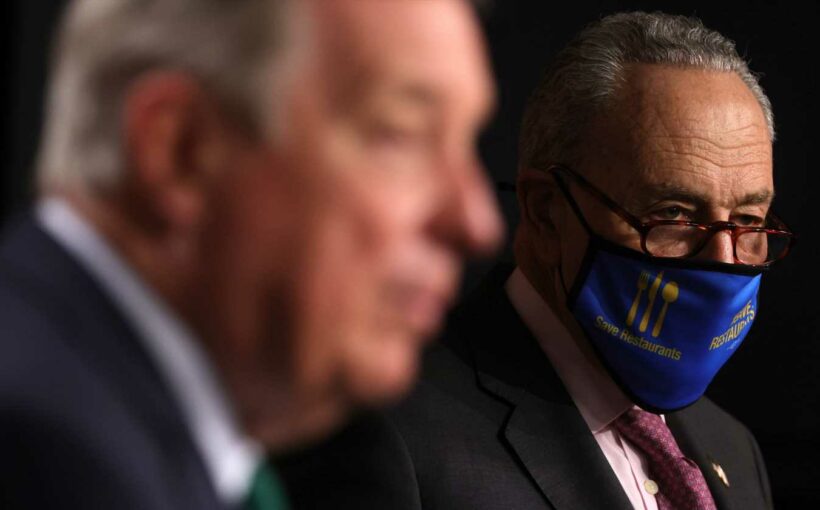WASHINGTON – Democrats have unified control of Congress and the White House for the first time in a decade, an opportunity the party wants to use to enact an ambitious agenda of stronger labor laws, expanded health care and sweeping packages on infrastructure, climate change and voting rights.
Yet the fate of that agenda — and any legislation passed in Congress — hinges on a rule of the Senate that requires 60 votes to end debate before a simple majority can pass any bill..
The filibuster, once an obscure procedure, has been increasingly used to stall priorities of the majority coalition, most notably on issues relating to race and civil rights. When senators have been at their most intransigent, majority parties have created filibuster exceptions for key areas of legislating, including for executive and judicial appointments.
Now, with a 50-50 Senate split putting the fate of Democrats’ priorities in the balance, many in the party are calling on the Senate to abolish the practice entirely.
“The filibuster is still making a mockery of American democracy,” Sen. Dick Durbin, D-Illin., the second-highest-ranking Democrat in the Senate, said during a March 10floor speech.
“The filibuster is still being misused by some senators to block legislation urgently needed and supported by a strong majority of the American people,” he argued.
Even President Joe Biden, a longtime senator, expressed openness to reforming the practice, which once expected senators to talk on the floor to delay legislation, often for hours.
“I don’t think that you have to eliminate the filibuster; you have to do it, what it used to be when I first got to the Senate back in the old days,” Biden said during a Wednesday interview with ABC News. “You had to stand up and command the floor, and you had to keep talking.”
Defenders, including Sens. Joe Manchin, D-W.Va., and Kristyn Simena, D-Ariz., argue the supermajority rule encourages bipartisan compromise and general decorum of the Senate. Republicans, including Senate Minority Leader Mitch McConnell, R-Ky., have said the filibuster protects the rights of the minority party.
McConnell warned Tuesday that removing the filibuster would lead to a “completely scorched earth Senate,” cautioning that whenever Republicans again held the majority they would pass an expansive conservative agenda, and Democrats would have little recourse to stop them.
Senate Minority Leader Mitch McConnell on Feb. 13, 2021, in Washington, D.C. (Photo: J. Scott Applewhite/AP)
“If I became skeptical of the filibuster, it’s because of your use of it,” Durbin had said in floor speech, directly addressing McConnell, saying the Kentucky Republican “can’t have it both ways. It can’t be a rare procedure and be a procedure that dominates the actual business of the Senate as this has done for so many years.”
Much of the modern debate about the filibuster center on the merits of different governing philosophies, longstanding norms and cold political calculus. Yet the origins of the supermajority threshold were much more accidental.
Realized as a quirk of Senate rules, it has since been entrenched through precedent. Here is how American politics reached this pivotal moment.
What is a filibuster?
A filibuster is a practice whereby any lawmaker can stall action by extending debate or using other tactics. Such strategies are as old as representative democracy — in 60 B.C., Cato the Younger effectively filibustered the Roman Senate.
The word “filibuster” has its origins in piracy. Dutch, French and Spanish all share words referring to “vribuyter,” “flibutier” and “filibustero,” or pirates who would plunder ships and colonies. The word was eventually imported into English as “flee-booter,” meaning a pirate who steals loot or “booty.”
By the 19th century, flee-booters had become “filibusters.” The word then became an insult in Congress, with politicians accusing lawmakers who held up legislation with a filibuster of effectively raiding the Senate.
The American filibuster is 215 years old
The filibuster as a legislative tool was accidentally created in 1806,when the Senate, at the urging of Vice President Aaron Burr a year before, eliminated the “previous question” motion, a then-rarely used rule that allowed the Senate to vote to move on from the issue currently being debated. That unexpectedly opened the door for senators to continue debate on a topic indefinitely — the filibuster.
It wasn’t regularly used until the mid-19th century, when pro-slavery senators used the tactic to stonewall debate over the limiting or abolition of slavery. There was no procedure to end a filibuster, so pro-slavery politicians like Sen. John C. Calhoun of South Carolina stifled abolitionist and “free soil” measures against slavery’s expansion with impunity.
The filibuster was effectively only limited by Senate norms and the personal relationships between lawmakers until 1917, when the Senate enacted the cloture rule. The new rule, passed to support the American war effort in World War I, allowed two-thirds of senators to end debate on the current topic.
Sen. Strom Thurmond after his filibuster on Aug. 29, 1957, in Washington, D.C. (Photo: AP)
In past political eras, the filibuster was infrequently used and often overruled by the governing coalition. The exception during the 20th century was civil rights law. Southern senators supportive of the Jim Crow system of racial segregation and white supremacy used the filibuster to vehemently oppose any expansion of educational, economic or voting rights for Black Americans.
Indeed, the longest filibuster in U.S. history was South Carolina Sen. Strom Thurmond’s filibuster of the Civil Rights Act of 1957;he spoke for 24 hours and 18 minutes in opposition. Thurmond and other Southern senators successfully stalled the bill’s passage from March to June in 1957.
Senators also filibustered the Civil Rights Act of 1964 for two months until 71 senators eventually came together for a cloture vote.
The evolution of the modern filibuster
Recent decades have seen the filibuster’s influence over all types of legislation grow, causing frustrated majorities to createexceptions for when the practice can be used.
In 1975, the number of votes needed to invoke cloture was brought down to the 60-vote threshold required to break a filibuster today. Later years brought minor limits on debate after a filibuster was ended.
The 1970s also saw the Senate adopt new rules that allowed a senator to filibuster one topic while the chamber moved on to different business. The change, on top of the growing policy divisions between the two major parties and the increasing fragility of congressional majorities, caused the filibuster to be used for all types of Senate proceedings.
Starting in the 1990s, the filibuster progressively became a tool of the minority party to thwart the policy ambitions of the majority.
President Bill Clinton’s health care reform package was stalled by filibusters, frustrating the White House so much they debated ending the rule. During the George W. Bush administration, Democrats used the filibuster to stop judicial nominees whom they saw as too radical.
In 2013, after Republicans stonewalled any judicial nominee from President Barack Obama, the Democratic Senate eliminated the filibuster’s 60-vote threshold for the confirmation of lower court judges. Obama said the move was necessary to overcome “an unprecedented pattern of obstruction” from the opposition.
In 2017, Republicans expanded the judicial carveout for the filibuster to include Supreme Court confirmations, clearing the way for Justice Neil Gorsuch to ascend to the high court.
The Senate has two ways to get around the modern filibuster: a “unanimous consent” motion and budget reconciliation. For a unanimous consent vote, all senators are asked if there are any objections to any debate on a given bill. If any senator objects then debate continues.
In budget reconciliation, a bill may be passed with a simple majority if all its provisions relate to the federal budget. This process was recently used to pass the American Rescue Plan, Democrats’ $1.9 trillion spending package.
Future of the filibuster
At the start of 2021, McConnell pressured Senate Majority Leader Chuck Schumer, D-N.Y., to promise to protect the legislative filibuster before Republicans would approve the rules to govern the new Congress. McConnell did so by effectively filibustering the rules package.
Ultimately, Manchin and Sinema allayed McConnell’s concerns, when they promised they would not vote to abolish the supermajority threshold.
The episode summed up the current dynamic: Senior Democratic leaders increasingly see the rule as a stranglehold on their agenda, and indeed governing in general. The pressure to pass at least some of the party’s top priorities is pushing Democratic leaders to call for filibuster reforms.
“There’s no way under the sun that in 2021 that we are going to allow the filibuster to be used to deny voting rights. That just ain’t gonna happen. That would be catastrophic,” Democratic Whip Jim Clyburn, D-S.C., told reporters March 7, directly calling out Manchin and Sinema.
Moderates have been difficult to read on the issue. Manchin, who briefly expressed openness to reforming the filibuster, quickly backtracked and emphasized he would “never” reform the rule.
Some Democrats on Capitol Hill are biding their time, assuming that Republicans will force the issue by not compromising on any of Biden’s policy priorities. “If the Republicans block S. 1, that will turn up the heat on taking away Mitch McConnell’s veto,” Sen. Elizabeth Warren, D-Mass., claimed, referring to the For the People voting rights bill.
But while the highly polarized Senate and anxious desire among many Democrats to fulfill their campaign promises points to a dim future for the filibuster, some senators have begun trying to pull the chamber back from the brink.
“It’s something the group of 20 of us, 10 Republicans and 10 Democrats, will discuss tomorrow and decide whether we take this up. Or whether instead, we focus on the minimum wage,” Sen. Mitt Romney, R-Utah, told Politico in his outline of a new centrist coalition trying to cooperate on bills.
Whatever senators ultimately conclude is the best path forward regarding the filibuster, the upper chamber has no doubt entered another political era in recent years, one reflective of the nation its lawmakers represent: closely divided, hyper-polarized and anxious about its future.
Source: Read Full Article

